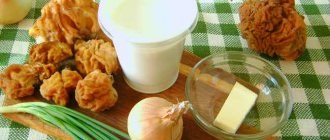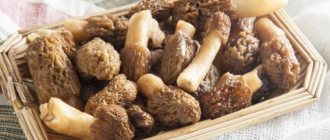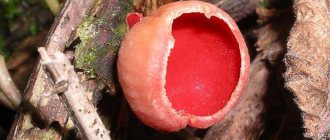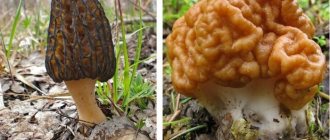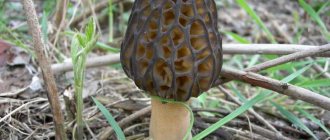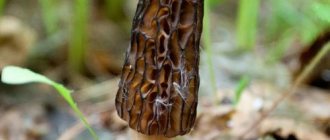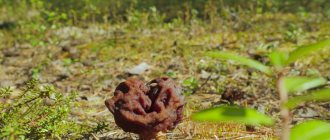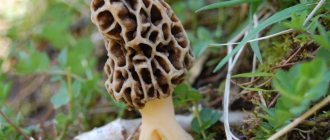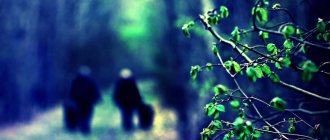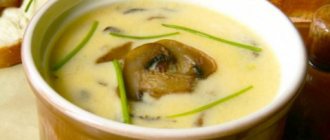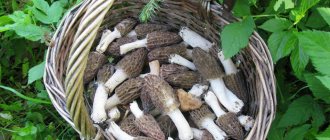Family Membership
Classification, as well as distinctive features, are different for mushrooms. Mycology classifies morels as members of the morel family or Phallus esculentus. The pretentious name, which in translation means similarity to the male organ, speaks of the unusual structure of the mushroom. The hat is cylindrical in shape on a small stem, well camouflaged against the background of rotted foliage. Due to ignorance of the beneficial properties and taste, reminiscent of chicken meat, it often causes jokes and foam from unknowing mushroom pickers. In European countries, it is highly valued and served in restaurants as an ingredient for preparing first and second courses, hot salads and appetizers. It is completely edible and can be compared in taste to champignons and boletus.
Strings are the complete opposite of morels. Unfortunately, mushrooms accumulate life-threatening carcinogens and poisons in their pulp. And although in Russia mycology classifies mushrooms as inedible or conditionally edible, depending on the variety, in Germany the lines are equated with fly agarics and toadstool.
Today you can still meet lovers of quiet hunting, collecting stitches. Unfortunately, they do not think about the dangers of consuming the pulp of a mushroom product after cooking. It has been scientifically proven that even the longest heat treatment is not able to completely remove gyromitrin. The poison persists, regardless of the efforts of the cook. An exception to the rule is species of the Discinaceae family, which are classified as conditionally edible. They can be eaten like mushrooms of the fourth category of edibility. Compared to morels, they do not provide any benefits, bright taste and aroma.
When studying the classification of mushrooms, you need to understand that the information will not be very useful during mushroom hunting. Much more often, the difference between the morel and the line that tells you whether the fruit is edible or not is what saves you. Photos of the differences, clearly demonstrated in the pictures below, help to visually remember the difference, noticeable to the naked eye.
Every year the list of life-threatening mushrooms expands. And although not all lines are still classified as inedible, containing life-threatening elements, collecting unusual mushrooms is not recommended. It is better to hunt for morels, wait for the May row and boletus, than to endanger your health and the lives of your family and friends.
Edible or poisonous, a brief history
Morels, despite their awkward appearance and memorable unusual shape, are famous for their captivating nutty aroma and “chicken” taste. Unknowingly, well-cooked mushrooms can easily be confused with tender chicken fillet served with ground nuts.
For many years, morels have been considered one of the best mushroom delicacies. Underrated in Russia, Belarus and Ukraine, they are loved by residents of European countries and CIS territories. Mushrooms are offered on restaurant menus as a separate dish or one of the ingredients used to prepare casseroles, salads and light snacks.
When collecting morels, you don't have to worry about safety. Mushrooms are classified as edible and conditionally edible, depending on the variety. After undergoing heat treatment, the fruits are safe and can be used in cooking. Fried and baked cooking options are more valued than preserved and pickled foods.
Stitches are dangerous mushrooms that easily cause poisoning in the body. Heavy poisons accumulated in the pulp of the fruit are dangerous because their quantity depends on environmental pollution. The closer the mycelium is located to a landfill, cemetery or highway, the higher the percentage of gyromitrin content. Of course, a similar rule applies to most of the family. There are also conditionally edible subspecies that are eaten after repeated heat treatment. However, whether the time spent on processing and preparation for the main preparation is worth it, each mushroom picker decides for himself.
The unusualness of the lines, which distinguishes mushrooms from the entire mushroom world, is the content of an unusual poison - gyromitrin. Its peculiarity is the accumulation effect. The more polluted the germination area is and the less precipitation the hydrometeorological center promises, the more poisons and carcinogens accumulate in the pulp. In many European countries, including Germany, the mushroom is strictly prohibited for consumption, regardless of the variety. The number of reported cases of poisoning leading to intoxication and death is sufficient. In Russia, not all mushroom pickers agree with this characterization of the lines. However, when going out into the forest to look for mushrooms, before filling your basket, you should always weigh the value of life and testing your luck so that you don’t come home empty-handed.
Mushroom toxicity
A characteristic feature of the autumn line is that the amount of toxic substances it contains is several times higher than in the ordinary line. Of the entire family of these mushrooms, it is the autumn one that is most dangerous for the human body.
A line that has not undergone any processing contains five to six times more hemolytic poison. This poison is extremely dangerous, because its amount of 50 mg per 1 kg of product weight can cause death.
The mushroom in its raw form contains 300 mg of such poison per 1 kg, which will certainly cause human death.
Nevertheless, mushroom pickers from different regions have different attitudes towards this type of mushroom. The reason for such a diversity of opinions will be discussed later.
Foreign sources
Any mushroom picker in a country with a warm, mild climate will say that eating autumn mushrooms in any form is strictly prohibited. And he will be right, because mushrooms growing in such climatic conditions are really unsuitable for both humans and animals.
In European countries, both autumn stitches and ordinary ones are toxic. This is due to the fact that the amount of poison in the lines is affected not only by the ambient temperature, but also by the temperature of the soil on which they grow.
Mushrooms growing in warm soil absorb more toxic carcinogens and other hazardous substances. The warmer the soil, the more poisonous and toxic the line. Thus, under no circumstances should you collect stitches in the forests of Europe.
Russian sources
As for Russia, the situation here is somewhat different. You may hear that a mushroom like the fall stitch can be edible if you learn how to properly process it using high temperatures.
However, in reality, everything is this way: since lines are the general name of the genus, one cannot assume that all its representatives are safe.
Only the string mushroom that ripens in March-April is suitable for cooking. At this time, the soil is still cold, not thawed, which is quite common in Russia, and toxic substances, if they enter the body of the fungus, are in smaller quantities.
The appearance of autumn stitch occurs in the fall - at this time of year the soil is still quite warm, so we conclude that only spring stitch is suitable for food.
Stitches and morels: how they differ + photo differences
When starting to study information about the varieties of mushrooms before harvesting in the spring, you should pay close attention to the differences between morels and strings. A brief description of each variety of mushroom with visual photos will allow you to visually remember the difference, eliminating the collection of poisonous mushrooms instead of an edible product enriched with protein.
In most cases, the distinctive features are shown on a visual table or photo with arrows indicating the difference between families. But we will not repeat the experiment, but on the contrary, we will tell you in more detail about the characteristics of each mushroom, showing pictures and photos as an example.
Short description
Having once seen a mushroom cap in person, even novice mushroom pickers stop wondering what is different and what it looks like. Morels have a cone-shaped upper part that does not hide the stem. Wrinkled structure with small depressions (holes), comparable to dried dried fruit. The lines are even more unusual. Their cap is round in shape with uneven contours. Many compare its structure to a walnut, which is larger than the stem.
In size, the lines are slightly larger than morels. Depending on the variety, the length and volume of the mushroom can exceed edible mushrooms by several centimeters.
In cross section, morels have a uniform structure, colored white or cream. When collected in a bag or basket, they are often deformed and broken into pieces. Collection is recommended exclusively in a bucket or basket. The stitches in the section are not uniform and are fragile when pressed on the flesh.
The most important difference between mushrooms is the stem. When collecting morels, it is clearly visible, thanks to the equal division of the cap and stem into halves. Height - up to 13 cm, but most often does not exceed 10 cm. It is easy to detect mycelium on a damp surface where the snow has recently melted. Most often, fruits germinate in aspens, coniferous substrate or moss. Stitches, on the contrary, have an inconspicuous leg, often hidden under the cap. Despite the same place of germination, when comparing mushrooms with similar names, it is easy to find differences between families if you look closely. For example, the pattern on the mushroom cap is completely different. Edible spring mushrooms have uneven stripes on the cap, like a honeycomb. The stitches are similar to walnut.
Short description
Color varies. Mushrooms, depending on the variety, are colored in a range of brown, gray and yellow shades. However, when comparing mushrooms, one cannot help but notice that the color saturation is more acceptable for stitches. The hats have a bright color scheme, visible to the naked eye against the background of wet leaves that have fallen in the autumn.
Morels give off a mushroom aroma due to their nutty notes. Stitches have a neutral, less often unpleasant, odor. The difference depends on the place of germination and the variety of subspecies. As mentioned above, you should not pick mushrooms based only on appearance and aroma. Even proverbs say that appearances can often be deceiving.
Varieties of morels: are they poisonous, with photos
Morels are not dangerous. With the ability to distinguish edible and conditionally edible mushrooms from those that have a large percentage of poisonous subspecies, a mushroom picker can collect a whole basket of a delicious product for cooking. The main rule for safety is heat treatment, which removes toxins from the pulp of any mushrooms used as an ingredient in main and secondary dishes.
Common morel
One of the most common varieties. Scientifically, it is the common morel (Morchella esculenta). Due to the fusion of the cap with the stem, the mushroom is often confused and classified as a stitch. A distinctive feature that eliminates any doubt about the relationship of the species is a pattern in the form of “uneven honeycombs”, reminiscent of cells for collecting honey.
Brief description in the photo
- The hat is cone-shaped, uneven in shape.
- The leg is white or milky in color, not exceeding 11 cm in length.
The main disadvantage of the subspecies is the cells on the caps. In wet weather they become home to insects and slugs. To use a pure product for food, you cannot do without soaking. The recommended soaking time in salt water is 1.5 to 2.5 hours. If necessary, change the water several times, replacing the salty version with running water.
Conical morel
Based on the name, it speaks about the structure of the stem and cap. Belongs to the morel family. Myceliums are located only in areas with high humidity. Prey can be found in depressions, moss and wet leaves left after the snow melts. Germination continues until the topsoil is completely dry and there is no rain. The fragility of the pulp does not allow the morel to remain fresh and suitable for harvesting for a long time.
Description of the view in the photo
Common characteristics:
- a hollow cap with a pattern visually similar to volumetric cells;
- the length of the cap, without measuring the stem, reaches 8-9 cm;
- the mushroom is divided into two parts, with the upper one being larger than the lower one in volume;
- the shade of the upper part is brown;
- the leg is hollow, easily deformed when compressed.
Morel tall
Visually reminiscent of the previous subtype - “Conical”. However, it belongs to a separate variety of the morel family. Morchella elata or large morel, is described as a tall or large mushroom. The main difference between two similar morels is color and length. The tall cap is dark brown (red, brown-black) in color, and the length of the fruit as a whole exceeds 30 cm.
Description with photo example
The description of the cap, pattern and stem, by visual inspection, is almost no different from the morel family. You can suspect a predisposition to the tall subspecies only by color and height.
Steppe morel
Grows in the steppe zone. One of the largest morels in size, or Morchella steppicola, is common in Ukraine, Russia and Belarus. Often found before reaching forest-steppe, moss and marshy areas.
Short description
The photo below shows a real example of what the morel variety looks like in the picture. You can go in search of prey no earlier than the beginning of April, completing mushroom picking in mid-May, when spring weather is completely replaced by summer.
Mushroom structure:
- hat - resembles a line hat in shape. Painted in a light brown tint, less often milky;
- the leg is white, in rare cases milky. In cross-section, it is empty and fragile, not exceeding 2-2.2 cm in length.
It is better to go in search of this mushroom with an experienced mushroom picker or a clear photo example, which will not allow you to confuse an edible mushroom with a poisonous one. For beginners who are just learning the ropes of mushroom hunting, it is better to choose another variety of morels for collecting in order to reduce the risks of poisoning.
Scaly polypore (variegated). Elm (Polyporus squamosus)
There are several names for this fungus in the literature: variegated tinder fungus, elm fungus, hare fungus, and variegated fungus.
It grows on living and dead trees of various broad-leaved species, but most often on elm, elm and maple. Fruiting bodies appear annually in mid-May-June.
The cap is initially round, later kidney-shaped or fan-shaped, somewhat depressed towards the base. Its diameter is from 5 to 30 cm, thickness - 0.5-6 cm. The cap is elastic-fleshy, its surface is yellowish, creamy, ocher, the color of clay, with large brownish scales located concentrically. The underside of the cap is tubular, white or yellowish. Spore powder is white.
The leg (stump) is lateral, or eccentric, bent, less often straight, well developed, thick and dense. The upper part is reticulate-porous, white or yellowish, and the base is dark brown or almost black. The pulp is soft and fleshy at first, but in older mushrooms it is hard, spongy-corky, and crumbly.
The scaly polypore is edible at a young age, category 4. Used fresh, dried, in the form of mushroom powder, suitable for pickling after boiling.
Lines - poisonous and conditionally edible varieties
Despite concerns regarding the collection of strings, the family includes not only poisonous, but also conditional mushrooms that are acceptable for cooking after prolonged heat treatment. In order not to make mistakes when collecting, it is worth familiarizing yourself with the most common subspecies found in the regions of Russia.
Ordinary stitch
A classic mushroom, one of the most common in Russian cities where there are forest belts of aspen or coniferous trees. Myceliums are often found on sandy soils, where the moist environment lasts longer.
Fruiting lasts from mid-March until May 15th. The timing may vary depending on the climatic characteristics of the germination area. In colder areas, fruiting begins later and ends with the onset of a hot climate, warming the air to 16-18 degrees Celsius.
Structure:
- The cap is small, reaching a length of 20-23 cm. It has a rounded outline of an uneven shape. Painted in chestnut or brown shades;
- the leg is half hidden under the cap. Less than half the length of the upper part. When cut, it is hollow and fragile;
- the aroma is neutral. Has subtle mushroom notes.
The line is gigantic
One of the largest representatives of its kind. The structure of the cap resembles a walnut. As is typical for all stitches, the leg is practically invisible, hidden behind the cap.
Description with photo example
In cross-section, it is hollow and does not have an even contour. Has multiple folds. The hue is rich brown-red, less often gray-yellow. The leg is light, close to white.
This is one of the few subtypes of stitches classified as conditionally edible. It is eaten after long-term heat treatment, which means:
- soaking in salt water for 2-4 hours;
- repeated boiling with changing broth.
The mushroom contains a small amount of gyromitrin, which can accumulate in the human body. The danger lies in the unexpected effect. A mushroom picker can consume mushrooms for years and become poisoned a few years later. In order not to risk your health, it is better to choose a more suitable edible mushroom for collecting, one that does not contain toxins and poisons in the pulp, even in minimal quantities.
You can find mushrooms in the birch forest belt. A distinctive feature is its large structure and rich color.
Autumn stitch
Many people attribute these lines to the first mushrooms with which the spring picking season begins. But if you delve deeper into the study of mycology, you will find out that one of the varieties of Stochka germinates in the autumn. “Autumn” has an unusual appearance. His red hat resembles horns. The leg is thin, noticeable against the background of the unusual cap. Having seen a photograph of this variety of stitch, even a novice mushroom picker will remember its special features.
Peculiarities:
- an unusual round-shaped hat resembling horns;
- thin leg up to 12 cm in height;
- cylindrical shape;
- increased fragility;
- classified as poisonous and not suitable for collection.
Germinates from mid-summer to the end of September. Fruiting ends with the arrival of cold weather.
Where do morels grow in 2022?
In search of morels, you can go both to the forest zone and to open areas where birch and aspen trees grow, there are swamps, and there is coniferous litter that retains the moisture necessary for the active fruiting of the mycelium.
In the deciduous forest
In the central zone and central part of Russia, mushrooms are most often found in main forest belts, meadows and open areas with sandy soil.
The conical morel can only be found in coniferous forests, less often near oak groves. Mushrooms germinate both in old plantings and in young plants planted no later than 10 years ago. It is better to collect after rain or snow melting so that the soil does not have time to dry out.
The giant morel is more unpretentious to the area of germination and is more often found than others in the most unusual places: planting poplar and other deciduous trees, field plots and meadows where no human has set foot for a long time.
When choosing a favorable day for quiet hunting from April to May, you should focus on the following factors:
1) Humidity. Mushrooms germinate only in damp weather; with the onset of heat, fruiting stops.
2) Fruiting time lasts from late March to early June. The timing may vary by several weeks, depending on the region of germination.
3) Fruiting does not exceed four weeks.
4) You can find a harvest in the deciduous and coniferous zones. To increase your luck, it is better to choose mixed forest belts.
Morels and strings do not bear fruit for long. Active germination begins with the onset of above-zero temperatures, as soon as the snow begins to melt. Growth stops with the sudden arrival of a hot climate, which is not typical for the natural habitat of spring mushrooms.
Morels can only be discovered in the spring. However, high productivity allows for a good harvest for a long time. Many cooks freeze the fruits in the freezer after heat treatment, gradually using them as an ingredient for preparing mushroom dishes.
Many mushroom pickers are afraid to collect morels because of their unusual appearance. And only gourmets who know a lot about the taste and aroma of the delicacy go out every year in search of edible prey. It is not for nothing that in many countries the usefulness and taste of mushroom products are compared with boletus, chanterelles and champignons.
Video of collecting morels (morel caps):
Application
The stitches have found application in folk medicine and cooking. Despite the lack of high taste properties, they are used as the first spring mushroom.
In medicine
In folk medicine, recipes for alcohol tinctures are used to treat the following diseases:
- Osteochondrosis.
- Arthritis.
- Rheumatism.
- Radiculitis.
- Myopia.
- Myositis.
- Pancreatic diseases.
To prepare the remedy, you need to pour 30 g of dry raw materials with 500 ml of vodka. The tincture is placed in the refrigerator and kept for 2 weeks. It is then used to treat painful joints. The procedure is performed up to 3 times a day. If you experience a rash or other symptoms of intolerance after rubbing, you should seek medical help.
In cooking
Fruiting bodies should not be consumed raw. For safety reasons, they are boiled twice for 15 minutes or soaked in water for several days. A large amount of liquid is used for boiling. In this case, it is better to pour out the finished broth. Processed mushrooms can be pickled, fried, stewed or pickled.
Trophies are characterized by resistance to drying or freezing. The pulp is cleared of all toxins and poisonous substances only during a 4-week treatment.
In a freezer with a temperature below 18°C, the shelf life is 1 year.
Fresh pulp will keep in the refrigerator for up to 3 days.
stitches are used in cooking, but at the same time observing the necessary cooking rules
Where are the lines growing in 2022?
Fruiting sites are identical to morels. Before you go in search of a mushroom that has a large number of poisonous subspecies, you should think repeatedly whether collecting it is worth the risk of harm to your health and the condition of your loved ones. It is better to prefer edible morels or wait for the mushrooms, which germinate a little later.
It is not difficult to detect the lines; most often they sprout in the vicinity of coniferous trees or deciduous forest belts. Found near aspen and birch trees, swampy areas.
Taste qualities of morels and strings
Comparing edible mushrooms with conventional and poisonous ones is not entirely correct. However, the taste qualities of strings and morels are similar. The only difference is the aroma. The morel family has subtle nutty notes, comparable to a ready-made mushroom dish seasoned with ground nuts.
Morels taste like boiled chicken, which makes people on a diet or fasting popular. Some people use dried mushrooms as a dressing for preparing soups based on vegetables, cereals and herbs.
Morels go well with meat, sour cream, onions and soy sauce.
It is not recommended for pregnant women, children, nursing mothers and people with chronic diseases of the gastrointestinal tract, kidneys, liver, heart and cerebral vessels to consume any mushrooms, either their own or purchased from grandmothers at the market.
Video:
Family Asteraceae (Asteraceae): characteristics, representatives, formula
Morels, like primroses, appear earlier than other mushrooms. Their usefulness, taste and aroma distinguish the morel family among forest products, making the crop a delicacy and valuable for use in both cooking and medicine. Based on their pulp, medicinal companies produce dietary supplements that are useful for cataracts and blood diseases. And restaurants and experienced chefs do not miss the chance to prepare dishes with excellent qualities.
If you want to learn more about indoor flowers and plants, visit the helpful website Rastenievod.com. Here you can find descriptions and rules for growing a wide variety of plants, including the rarest species.
